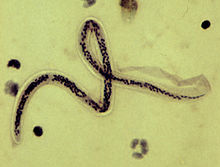| Wuchereria bancrofti | |
|---|---|

| |
| Microfilaria of Wuchereria bancrofti, from a patient seen in Haiti. Thick blood smears stained with hematoxylin. The microfilaria is sheathed, its body is gently curved, and the tail is tapered to a point. The nuclear column (the cells that constitute the body of the microfilaria) is loosely packed, the cells can be visualized individually and do not extend to the tip of the tail. The sheath is slightly stained with hematoxylin. | |
| Scientific classification | |
| Domain: | Eukaryota |
| Kingdom: | Animalia |
| Phylum: | Nematoda |
| Class: | Chromadorea |
| Order: | Rhabditida |
| Family: | Onchocercidae |
| Genus: | Wuchereria |
| Species: | W. bancrofti
|
| Binomial name | |
| Wuchereria bancrofti (Cobbold, 1877)
| |
| Synonyms[1]: 484–485 [2] | |
| |
Wuchereria bancrofti is a filarial (arthropod-borne) nematode (roundworm) that is the major cause of lymphatic filariasis. It is one of the three parasitic worms, together with Brugia malayi and B. timori, that infect the lymphatic system to cause lymphatic filariasis. These filarial worms are spread by a variety of mosquito vector species. W. bancrofti is the most prevalent of the three and affects over 120 million people, primarily in Central Africa and the Nile delta, South and Central America, the tropical regions of Asia including southern China, and the Pacific islands.[3] If left untreated, the infection can develop into lymphatic filariasis.[4] In rare conditions, it also causes tropical pulmonary eosinophilia. No vaccine is commercially available, but high rates of cure have been achieved with various antifilarial regimens, and lymphatic filariasis is the target of the World Health Organization Global Program to Eliminate Lymphatic Filariasis with the aim to eradicate the disease as a public-health problem by 2020.[5] However, this goal was not met by 2020. [6]
- ^ Laurence, B.R. (1989). ""Barbadoes leg": Filariasis in Barbados, 1625–1900". Medical History. 33: 480–488. doi:10.1017/s0025727300049954. PMC 1035937. PMID 2682083.
- ^ McFadzean, James A. (1952). "Investigations into the Cause of Microfilarial Periodicity". British Medical Journal. 1 (4768): 1106–1109. doi:10.1136/bmj.1.4768.1106. PMC 2023506. PMID 14925382.
- ^ Melrose WD (2002). "Lymphatic filariasis: New insights into an old disease". Int J Parasitol. 32 (8): 947–60. doi:10.1016/S0020-7519(02)00062-0. PMID 12076624.
- ^ "Wuchereria bancrofti: The causative agent of Bancroftian Filariasis". ww.nematodes.org. Archived from the original on 3 January 2019. Retrieved 20 February 2014.
- ^ Ramaiah, KD; Ottesen, EA (November 2014). "Progress and impact of 13 years of the global programme to eliminate lymphatic filariasis on reducing the burden of filarial disease". PLOS Neglected Tropical Diseases. 8 (11): e3319. doi:10.1371/journal.pntd.0003319. PMC 4239120. PMID 25412180.
- ^ "Ending the neglect to attain the Sustainable Development Goals: A road map for neglected tropical diseases 2021–2030". www.who.int. Retrieved 5 April 2023.